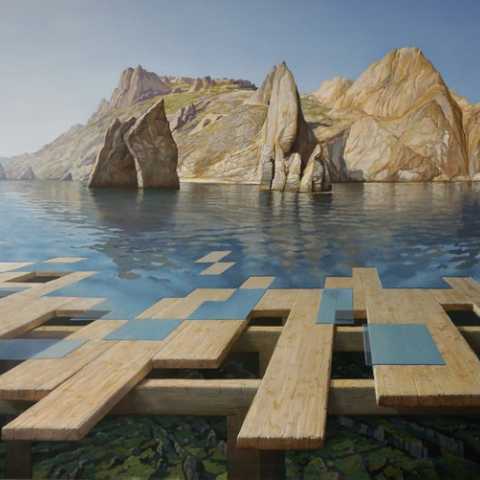Hay Hill Gallery
23 Cork Street
London
W1S 3NJ
United Kingdom



Sergey Sologub's new exhibition at Hay Hill Gallery promises to be a surreal fusion of ordinary landscapes and still-life, seen through a filter of science fiction. At first glance, these compositions appear meticulous with their technical skill and careful symmetry; on closer inspection, paradoxical angles emerge to disorient and unsettle the viewer.
The artist clearly has a love of steam-shrouded locomotives and floating Venetian islands- disguising a mischievous spirit within an atmosphere of hushed reverence, as though he were a mystic. All may seem perfectly normal- until you realise that there is a giant paper aeroplane settled in the desert landscape; or that houses are blooming from the dusty patterns of an elaborate Persian rug. His recurring themes are futuristic and ancient all at once.
Like Marco Polo returning to Kublai Khan with tall tales of unknown lands, Sologub unfurls his fantastical stories in exaggerated detail and clever sleight of hand. With the flawless technique of an old master- and a child's uninhibited imagination- Island hints at the magical realism of those would-be-worlds.
Giuseppe Linardi's show Decoded is a not-to-be-missed visual experience. The bright canvases are a matrix of optical sensations as disconcerting as magic-eye pictures or interactive screens; reminiscent of bit-map zeros and ones, the broad dots and dashes merge to unveil their hidden subjects. The works could be seen as a kaleidoscopic rendering of the data we leave in our wake- an endless obsession with documenting our existence.
The artist's clever manipulation of pigment acts like a zoetrope, with two dimensional tessellating planes that transform static images into a vibrant animation. They become metaphors for the intricate design of the universe; sprawling across the walls like digitally grown gardens, with shining green pixels blooming out leaves, stalks and branches. In the blink of an eye or the slowest shutter speed, everything is revealed to be interconnected; our atoms will eventually dissipate and reform in new prismic swarms.
Eternally curious about the stuff we are made of, we look for patterns to orientate ourselves, deciphering the cryptic signs. We have analysed genomics, heuristics and algorithms- depleting our natural resources in the hope that by unraveling these sums we may find a cure for cancers, colds and global warming- even venturing upon the more dangerous territory of cloning. Linardi's exhibition raises an interesting ethical debate on whether cracking these codes will lead us to be better stewards of our planet, or continue to destroy it.
